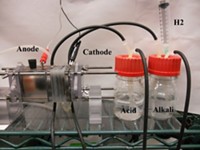Advertisement
Grab your lab coat. Let's get started
Welcome!
Welcome!
Create an account below to get 6 C&EN articles per month, receive newsletters and more - all free.
It seems this is your first time logging in online. Please enter the following information to continue.
As an ACS member you automatically get access to this site. All we need is few more details to create your reading experience.
Not you? Sign in with a different account.
Not you? Sign in with a different account.
ERROR 1
ERROR 1
ERROR 2
ERROR 2
ERROR 2
ERROR 2
ERROR 2
Password and Confirm password must match.
If you have an ACS member number, please enter it here so we can link this account to your membership. (optional)
ERROR 2
ACS values your privacy. By submitting your information, you are gaining access to C&EN and subscribing to our weekly newsletter. We use the information you provide to make your reading experience better, and we will never sell your data to third party members.
Environment
Microbe-Powered Device Desalinates Water While Generating Hydrogen
Water Desalination: New system could be a step toward energy-efficient desalination
by Kellyn Betts
November 24, 2010

A team of researchers from Pennsylvania State University has designed the first device powered by bacteria that can remove salt from water and generate enough energy in the form of hydrogen to offset its energy needs (Environ. Sci. Technol., DOI: 10.1021/es1025646). Environmental engineer Bruce Logan and his colleagues believe that one day their device could pair with conventional desalination technologies to create an energy-efficient route to drinkable water from salty sources.
In the early 2000s, Logan's group pioneered the development of microbial fuel cells that harness the ability of some bacteria to generate electrical power. More recently the group has found ways to alter these devices to desalinate briny water.
In 2009, Logan and his group created a three-chambered device that desalinates salty water sandwiched between two membranes. Bacteria grow on the device's anode and release electrons as they consume organic compounds, such as acetic acid, in the water. The microbe-generated electricity then creates an electrical potential across the device that pulls sodium and chloride ions out of the water through the membranes toward the electrodes.
But the technology—which was named Environmental Science & Technology's top technology paper of the year—has a downside: The voltage it produces decreases as the water's salinity declines, which limits its practical applications.
The group's new device, called a microbial electrodialysis cell, overcomes this shortcoming by adding a feature from modified versions of Logan's microbial fuel cells. In these fuel cells, Logan's team applied a small voltage over the microbes, which enabled them to completely degrade acetic acid and produce hydrogen gas.
When the engineers applied 0.55 V to their electrodialysis cell, they found that it consistently produced more than twice as much energy in the form of hydrogen as needed to produce the voltage boost. If they fed that gas into a hydrogen fuel cell, the researchers could convert it into enough electricity to maintain an optimal electric potential for desalination, essentially making the device self-sustaining, Logan says.
The new microbial electrodialysis cell's ability to produce a steady supply of hydrogen that can be stored for later use represents a significant advance, says Zhiyong (Jason) Ren of the University of Colorado, Denver. Ren's group has a paper in press at Environmental Science & Technology that describes the independent development of a similar technology.
Logan envisions that any excess power generated by these microbial electrodialysis cells could drive other desalination steps, such as reverse osmosis.




Join the conversation
Contact the reporter
Submit a Letter to the Editor for publication
Engage with us on Twitter